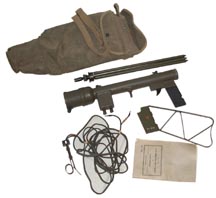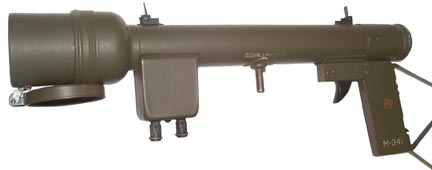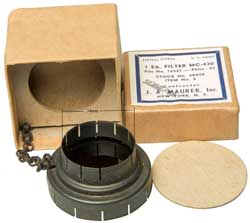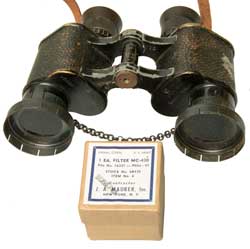M-227 Signal Lamp Equipment SE-11
© Brooke Clarke 2007 - 2022
I think that both the M-227 and M-132 were built in response to these two patents on the use of red light for signaling in daytime. The red filter is not an added feature but a necessary part of the device.
There are two aspects:
1. The eye has poor sensitivity to red light so it would be difficult or impossible to see a very faint red light outdoors during the day. This means the enemy would not see the signal, but an observer wearing red lens goggles that block out daylight would see the signal. If binoculars are used they should include the rubber eye guards to block out daylight.An experiment would be to see if wearing dark sunglasses would work to see the red signal.
2. The design of the optics is based on a collimator so that an image of the filament is projected as if coming from infinity. This makes it hard to aim so in both patents he uses the idea of the eyepiece focal plane being coincident with the filament so that when looking through the telescope the location of the filament can be used. But I think that's over kill since the observer can make a head movement of a few inches to accomplish the same end. But this may be the reason the M-132 has the fine pointing capability. It would be interesting to test that.
1346580 Flash-telescope, Robert W Wood, App: 1919-02-25, Pub:1920-07-13, 398/131,359/399 -
I suspect the mark ups are related to some legal dispute.
398: Optical Communications
/118 Over Free Space
/131 " including alignment
/172 Transmitter and Receiver System \ including visible light modulation
359 Optical: Systems and Elements
/350 Having Significant Infrared or Ultraviolet Property
/399 Compound Lens System \ Telescope
362 Illumination
/253 Combined
/293 Light Source and Modifier \ Including Wavelength modifier (e.g. filter)
116 Signals and Indicators
/18 Code Signaling
33 Geometrical Instruments
/227 Straight-Line Light Ray Type
1517332 Signaling system, Robert W Wood, App: 1919-10-30, Pub: 1924-12-02, 398/118,362/293,359/399,362/253,116/18,398/172,33/227,359/350 -


 |
The loop is electrically connected to the
terminal on it's side of the key but the paddle is
electrically insulated from both contacts. That way
you don't get a shock, unless you touch the other
conductor. When the relay opens it produces a "kick"
voltage. If this key was used with a transmitter and
if one side of the keying circuit was ground you would want
ground on the loop side. Of course pretty much any other manual More key could be used, but not the Vibroplex (wiki) type because there's a turn on time associated with filament lamps so high speed dots would not work. That could be fixed by replacing the filament lamp with an LED. |
 |
This pair of filters can be attached to
binoculars (not goggles). B&L M3 6x30 and the opposite end fits a Zeiss D.F 6x24.standard 6x30 and 6x24 as long as the outer size of the objective tubes are the same for the filter adapter clamps. M3 & REL Canada 6x30 was the standard military model for ground US forces. Later models got better sealing and some with coated optics. Label: Signal Corps. U.S. Arm 1 Ea. Filter MC-430 File No. 16321 -- Phila - 43 Stock No. 68430 Item No. 6 Contractor J. A. Maurer, Inc. New York, N.Y. |
||||
34mm = 6x30 EE Binocular objective end dia. |
|
||||
 |
The Army Signal Corps EE 6x30
Binoculars work with the MC-430 ref filters. |
Includes the M-132 Signal Lamp, MC-430 Filter, M-172 Goggles, J-46 Key, FT-159 Lamp Mount, CD-332 cord, Tripod type G, with bronze head (SIG_8-EE-84.pdf)
The thing that I don't understand expense associated with: bubble level, Through compass, Azimuth dial, Elevation dial and gears, optical telescope. These add a great deal of cost, but why?
Note the filter and goggles are common with the M-227. The Goggles are not used with the filters.
The MC-430 filters can be fitted to binoculars, not goggles.
A Morse key is a part of the set. But it still might be intended as a survey post light rather than a communication device. It would located on high ground and would need the azimuth and elevation settings to aim at the surveying transit location?
All the other Signal Lamps I've seen use non optical sights and are aimed using an eyeball and hand. This seems closer to a surveying instrument. Let me know.
For various reasons is was not adopted, see the YouTube: At Ease, Soldier!: WW2 US Army Signal lamp EE-84, 3:59 -
Some information at G503.com (EE-84 lamp) - BX-22 contains 8 "BA-30 ("D" cell) batteries in parallel pairs.
The Dim switch position is 4.5 Volts and the Bright switch position is 6.0 Volts.
The Army EE-8 is a field telephone. The Survey Signal Lamp 2 Inch has azimuth and elevation positioning, a sight so is very similar in capability and costs a tiny fraction of what the M-132 would cost.
Photos from Kien.
When were pop rivets invented?The above may just be eyelets (tubular rivet).Fig 10 looks like pop rivets.
1916 by Hamilton Wylie (Made Up In Britain)
GB106169 Improved Means of Closing Tubular Rivets, Hamilton Neil Wylie, 1917-05-17 -
| 3021516 | February 1962 | Spitz et al. |
| 3142052 | July 1964 | Tambert |
| 3300582 | January 1967 | Himes et al. |
| 3496294 | February 1970 | Emanuels |
| 3205487 | September 1965 | Vriend |
| 3614528 | October 1971 | Craddock |
| 3668684 | June 1972 | Johnson |
| 3764849 | October 1973 | Ohta |
| 3953763 | April 1976 | Herrick |
| 3205487 | September 1965 | Vriend |
| 3668684 | June 1972 | Johnson et al. |
| 3786494 | January 1974 | Clark |
| 3810150 | May 1974 | Jacobs |
| 4058679 | June 1978 | Hashimoto |
| 4124842 | November 1978 | Bachelor |
| 4163220 | July 1979 | Henningsen et al. |
| 4717913 | January 1988 | Elger |
| 4727600 | February 1988 | Avakian |
| 5289306 | February 1994 | Hirohashi et al. |
| 5416627 | May 1995 | Wilmoth |
| 5424859 | June 1995 | Uehara et al. |
| 1822619 | September 1931 | Grossman |
| 2498805 | February 1950 | Gurevsky |
| 2751490 | June 1956 | Emerson |
| 3030497 | April 1962 | Cheng |
| 3197757 | July 1965 | Porta |
| 3205487 | September 1965 | Vriend |
| 3800136 | March 1974 | Edelson |
Mance Type Mk V Heliograph
C-3 US Navy Infrared IR Signaling Telescope
Flashlights -
Binoculars in general Orion 9x63 astronomical (note with large (7mm) exit pupil diameter they work well at dusk and dawn)
Lights
PAS-6 Metascope IR viewer and source
T3C - Russian monocular Image Intensifier (star light scope)
TVS-2 Crew Served Weapon Sight
M18 IR Binoculars - near IR not hot people or car engines
M32 Periscope 105mm IR Gun Sight
MD-1 Automatic Astro Compass - also can see stars in the daytime
Astro-Compass for sighting Sun & stars
Periscopic Aircraft Sextant - Sun & stars
NextStar60 - cleaver microcontroller telescope using DC motors and shaft encoders
Celestron 8" Telescope with Equatorial wedge and tripod- This model has a clock drive but no computer control. It's big and heavy, not something you pull out for a quick 5 minute look up. Would be much better if used with a permanent pier. It takes quite some time to do a Polar alignment, but when done you can find about anything just using the hour angle and declination scales.
Cloud Detection - as part of weather forecasting like used as part of an automated observatory
Hughes Probe Eye far (heat) IR viewer
Shadow or Projection Clocks
PVS-4 Starlight Scope
PVS-5A Night Vision Goggles
Tripods
UAS-4 Infrared Surveillance System, AN/AAS-14 Infrared Detecting Set, MK-898/AAS-14A Optical Filter Kit
IR Beacon
Thermal Hand Held Imager DFOV
Optics - optical patents - optical bench